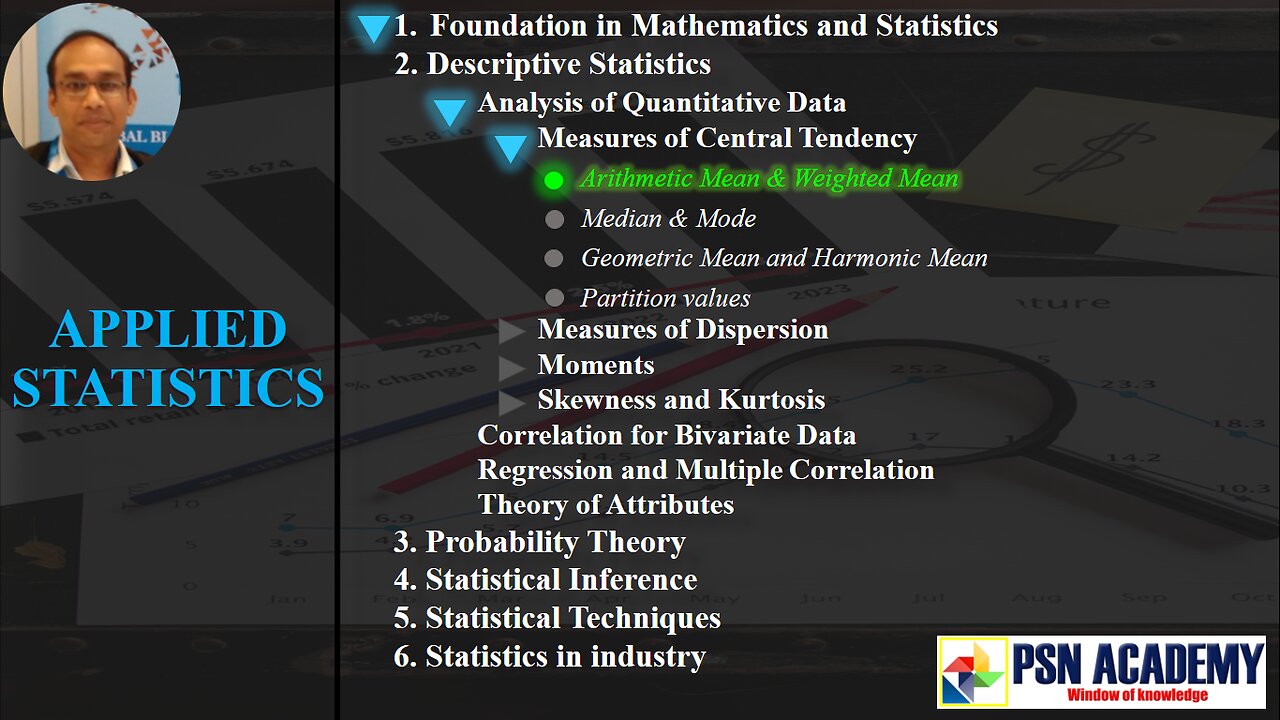Premium Only Content

2.1.1.2 Central Tendency | Median & Mode | Frequency | Grouped & Ungrouped data
In this video, you will get the idea of Central Tendency, Median & Mode, Frequency and Grouped & Ungrouped data.
-----------------------------------------------------------------------------
Median: Value of the variable which divides the whole distribution into two equal parts
Median class: The class in which the (𝑛/2)^𝑡ℎ cum. frequency falls. If 𝑛/2 is not present, 𝑛/2+1 will be considered to determine median class.
-----------------------------------------------------------------------------
Property 1: Number of the observations below and above the median is same.
Property 2: Median is not affected by extremely large or extremely small values or by open end class intervals.
When median is useful:
Useful when the distribution is skewed (asymmetric)
Merits of Median
1. Not affected by extreme values
2. Can be calculated for open end classes
3. Can be calculated even if the other classes are of unequal width
Demerits of Median
Not rigidly defined (a distribution may have more than one mode)
-----------------------------------------------------------------------------
1. For Ungrouped Data (Method 1)
If 𝑥_1,𝑥_2,…,𝑥_𝑛 are the 𝑛 observations then the arithmetic mean 𝑥 ̅=(〖𝑥_1+𝑥〗_2+…+𝑥_𝑛)/𝑛=(∑_(𝑖=1)^𝑛▒𝑥_𝑖 )/𝑛
If 𝑓_𝑖 is the frequency of 𝑢_𝑖their mean is 𝑥 ̅=(〖〖𝑓_1 𝑢〗_1+𝑓_2 𝑢〗_2+…+〖𝑓_𝑘 𝑢〗_𝑘)/(𝑓_1+𝑓_2+…+𝑓_𝑘 )=(∑_(𝑖=1)^𝑘▒〖𝑓_𝑖 𝑢〗_𝑖 )/(∑_(𝑖=1)^𝑘▒𝑓_𝑖 ), 𝑘 = Distinct observation count
1. For Ungrouped Data (Method 2)
Take deviations from any arbitrary point “A”. Then 𝑥 ̅=𝐴+(∑_(𝑖=1)^𝑛▒𝑑_𝑖 )/𝑛 𝑑_𝑖=𝑥_𝑖−𝐴
If 𝑓_𝑖 is the frequency of 𝑢_𝑖 then 𝑥 ̅=𝐴+(∑_(𝑖=1)^𝑘▒〖𝑓_𝑖 𝑑〗_𝑖 )/(∑_(𝑖=1)^𝑘▒𝑓_𝑖 )=(∑_(𝑖=1)^𝑘▒〖𝑓_𝑖 𝑢〗_𝑖 )/(∑_(𝑖=1)^𝑘▒𝑓_𝑖 )
2. For Grouped Data (Method 1)
If 𝑓_𝑖 is the frequency of 𝑚_𝑖 (the mid value of the 𝑖^𝑡ℎ class interval) their mean 𝑥 ̅=(〖〖𝑓_1 𝑚〗_1+𝑓_2 𝑚〗_2+…+〖𝑓_𝑘 𝑚〗_𝑘)/(𝑓_1+𝑓_2+…+𝑓_𝑘 )=(∑_(𝑖=1)^𝑘▒〖𝑓_𝑖 𝑚〗_𝑖 )/(∑_(𝑖=1)^𝑘▒𝑓_𝑖 ), 𝑘 = Distinct observation count.
2. For Grouped Data (Method 2)
If 𝐴 is an arbitrary point and 𝑓_𝑖 is the frequency of 𝑚_𝑖 (the mid value of the 𝑖^𝑡ℎ class interval) their mean
𝑥 ̅=𝐴+(〖〖𝑓_1 𝑑〗_1+𝑓_2 𝑑〗_2+…+〖𝑓_𝑘 𝑑〗_𝑘)/(𝑓_1+𝑓_2+…+𝑓_𝑘 )=𝐴+(∑_(𝑖=1)^𝑘▒〖𝑓_𝑖 𝑑〗_𝑖 )/(∑_(𝑖=1)^𝑘▒𝑓_𝑖 ), 𝑘 = Distinct observation count, 𝑑_𝑖=𝑚_𝑖−𝐴.
N.B.: It is illeagal to download, distribute or display in public any part of this video production.
-
 29:54
29:54
DeVory Darkins
1 day ago $14.43 earnedHegseth drops explosive speech as Democrats painfully meltdown over Trump truth social post
53.4K65 -
 19:39
19:39
James Klüg
1 day agoAnti-Trump Protesters Threaten To Pepper Spray Me For Trying To Have Conversations
15.7K16 -
 34:54
34:54
MattMorseTV
13 hours ago $26.01 earned🔴Trump just FIRED 154,000 FEDERAL WORKERS. 🔴
72.4K88 -
 2:03:32
2:03:32
Side Scrollers Podcast
21 hours agoMASSIVE Netflix Boycott + The TRUTH About Jimmy Kimmel’s Return + BIG Side Scrollers NEWS
35.6K15 -
 15:05
15:05
GritsGG
1 day agoFlawless Duos Victory w/ Most Winning Duo in Warzone History!
32.5K2 -
 1:53:52
1:53:52
FreshandFit
17 hours agoShe Was In 3 Domestic Violence Cases? Happy Birthday Fresh!!!
161K57 -
 2:03:22
2:03:22
Inverted World Live
9 hours agoThe Aliens Are Underwater | Ep. 117
70.1K29 -
 2:20:24
2:20:24
Badlands Media
17 hours agoDevolution Power Hour Ep. 394: The Long Game, Media Traps, and Military Signals
97.7K30 -
 2:08:38
2:08:38
TimcastIRL
11 hours agoNetflix Shares TANK, Elon Says BOYCOTT After Writer MOCKS Charlie Kirk Assassination
252K194 -
 8:48:01
8:48:01
SpartakusLIVE
13 hours agoI'M BACK || Quads w/ The Boys
95.4K9